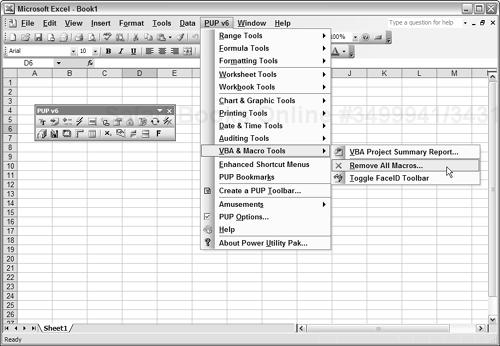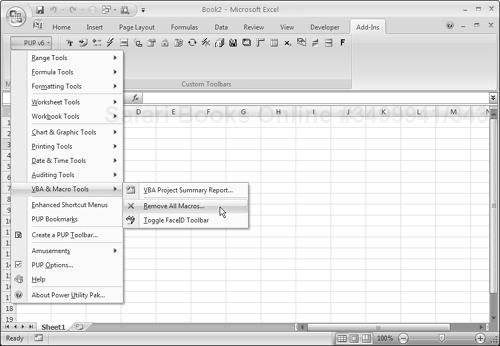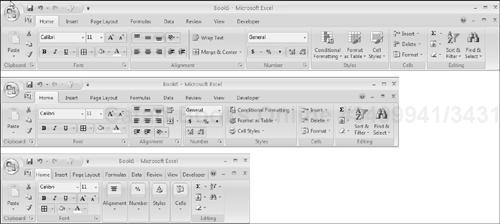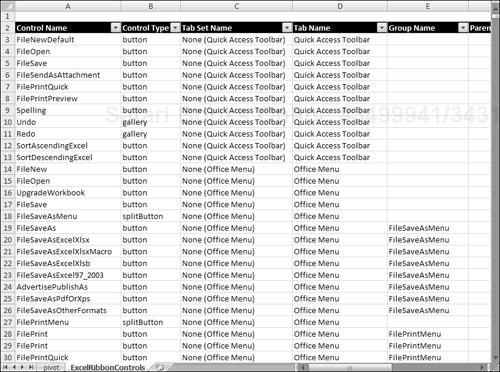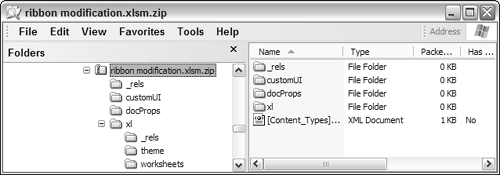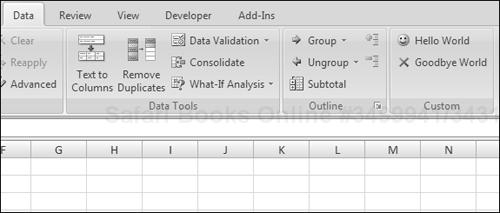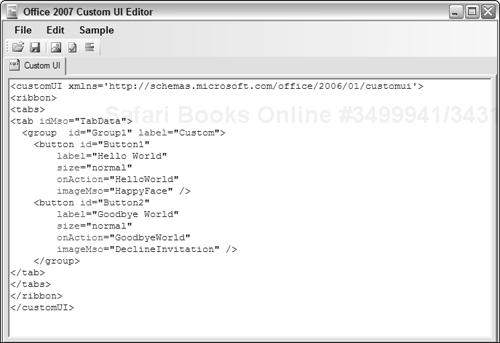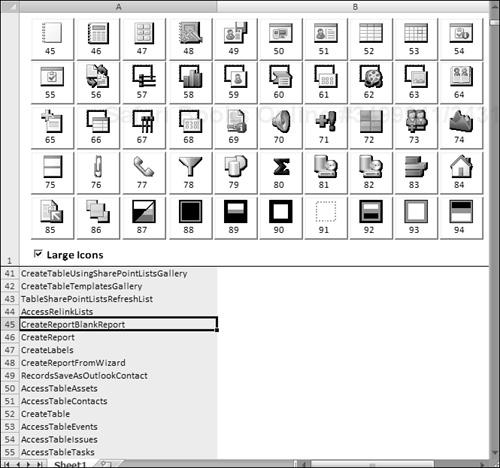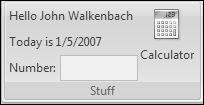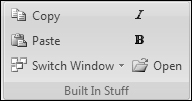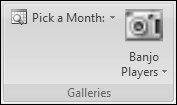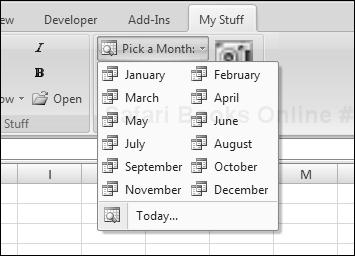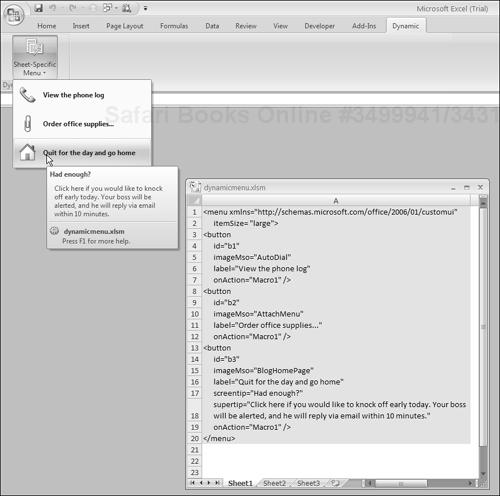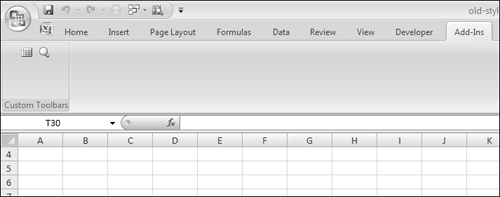In This Chapter
Perhaps the most significant change in Office 2007 is the new Ribbon-based user interface. This chapter provides an overview of the Ribbon and describes how it relates to VBA.
The new Excel 2007 Ribbon UI, from a user’s perspective
How you can use VBA to work with the Ribbon
An introduction to customizing the Ribbon with RibbonX code
Examples of workbooks that modify the Ribbon
Boiler-plate code for creating an old-style toolbar
The Ribbon is a brand new concept in user interface design. You use XML to modify the Ribbon, but there are a few Ribbon-related operations that you can perform with VBA.
The first thing you notice about Excel 2007 is its new look. The time-honored menu-and-toolbar user interface has been scrapped and replaced with a new tab-and-Ribbon interface. Although the new interface kind of resembles the old-fashioned menus-and-toolbars interface, you’ll find that it’s radically different.
Long-time Excel users have probably noticed that the menu system has become increasingly complicated with each new version. In addition, the number of toolbars has become almost overwhelming. After all, every new feature must be accessible. In the past, this access meant adding more items to the menus and building new toolbars. The Microsoft designers set out to solve this overcrowding problem, and the new Ribbon interface is their solution.
Time will tell how users will accept the new Ribbon interface. As I write this book, the reaction can best be described as mixed. As with anything new, some people love it, and others hate it.
I think many experienced Excel users will suffer from a mild case of bewilderment when they realize that all their familiar command sequences no longer work. Beginning users, on the other hand, will be able to get up to speed much more quickly because they won’t be overwhelmed with irrelevant menus and toolbars.
Because the Ribbon UI is new, I provide some additional user-oriented information in the sections that follow.
The commands available in the Ribbon vary, depending on which tab is selected. The Ribbon is arranged into groups of related commands. Here’s a quick overview of Excel’s tabs:
Home: You’ll probably spend most of your time in the Home tab. This tab contains the basic Clipboard commands, formatting commands, style commands, commands to insert and delete rows and columns, plus an assortment of worksheet-editing commands.
Insert: Select this tab when you need to insert something in a worksheet — a table, a diagram, a chart, a symbol, and so on.
Page Layout: This tab contains commands that affect the overall appearance of your worksheet, including settings that deal with printing.
Formulas: Use this tab to insert a formula, name a range, access the formula-auditing tools, or control how Excel performs calculations.
Data: Excel’s data-related commands are on this tab.
Review: This tab contains tools to check spelling, translate words, add comments, and protect sheets.
View: The View tab contains commands that control various aspects of how a sheet is viewed. Some commands on this tab are also available on the status bar.
Developer: This tab isn’t visible by default. It contains commands that are useful for programmers. To display the Developer tab, choose Office
 Excel Options and then select Popular. Place a check mark next to Show Developer Tab in the Ribbon.
Excel Options and then select Popular. Place a check mark next to Show Developer Tab in the Ribbon.Add-Ins: This tab is visible only if you’ve loaded a workbook or add-in that customizes the menu or toolbars (by using the
CommandBarsobject). Because menus and toolbars are no longer available in Excel 2007, these customizations appear in the Add-Ins tab.
The appearance of the commands on the Ribbon varies, depending on the width of the Excel window. When the window is too narrow to display everything, the commands adapt and may seem to be missing, but the commands are still available. Figure 22-1 shows three views of the Home tab of the Ribbon. In the top image, all controls are fully visible. In the middle image, Excel’s window is made narrower. Notice that some of the descriptive text is gone, and some of the icons are smaller. The bottom image shows the extreme case in which the window is very narrow. Some groups display a single icon. However, if you click the icon, all the group commands are available to you.
Tip
If you would like to hide the Ribbon to increase your worksheet view, just double-click any of the tabs. The Ribbon goes away (but the tabs remain), and you’re able to see about five additional rows of your worksheet. When you need to use the Ribbon again, just click a tab, and it comes back temporarily. To permanently restore the Ribbon, double-click a tab. You can also press Ctrl+F1 to toggle the Ribbon display on and off.
Now, the big question: What can a VBA programmer do with the Ribbon? The simple answer is this: not much.
Following is a list of what you can do with the Ribbon using VBA:
Determine whether a particular control is enabled.
Determine whether a particular control is visible.
Determine whether a particular control is pressed (for toggle buttons and check boxes).
Get a control’s label, screen tip, or supertip (a more detailed description of the control).
Display the image associated with a control.
Execute a particular control.
Following is a list of things that you might like to do with the Ribbon but that are not possible:
Determine which tab is currently selected.
Activate a particular tab.
Add a new tab.
Add a new group to a tab.
Add a new control.
Remove a control.
Disable a control.
Hide a control.
All told, Excel has more than 1,700 Ribbon controls. Every Ribbon control has a name, and you use that name when you work with the control using VBA.
For example, the statement that follows displays a message box that shows the Enabled status of the ViewCustomViews control. (This control is located in the View ![]() Workbook Views group.)
Workbook Views group.)
MsgBox Application.CommandBars.GetEnabledMso("ViewCustomViews")Determining the name of a particular control is a manual task. First, display the Customize tab of the Office ![]() Excel Options dialog box. Locate the control in the list box on the left, and then hover the mouse pointer over the item. The control’s name appears in a pop-up screen tip (see Figure 22-2)
Excel Options dialog box. Locate the control in the list box on the left, and then hover the mouse pointer over the item. The control’s name appears in a pop-up screen tip (see Figure 22-2)
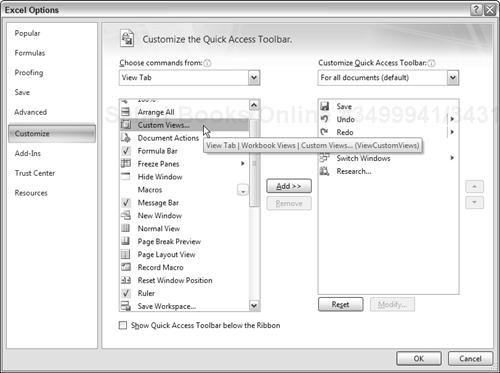
Figure 22-2. Using the Customize tab of the Excel Options dialog box to determine the name of a control.
Unfortunately, it’s not possible to write VBA code to loop through all the controls on the Ribbon and display a list of their names.
CD-ROM
The companion CD-ROM contains a workbook with the names of all Excel controls. The workbook also displays additional information about each control, including the control type, the tab name, and the group name. Figure 22-3 shows a portion of this file, which is named ribbon control names.xlsx.
In the previous section I provided an example of using the GetEnabledMso method of the CommandBars object. Following is a list of all the methods that are relevant to working with the Ribbon via the CommandBars object. All of these methods take one argument: idMso, which represents the name of the command.
ExecuteMso: Executes a controlGetEnabledMso: ReturnsTrueif the specified control is enabledGetImageMso: Returns the image for a controlGetLabelMso: Returns the label for a controlGetPressedMso: ReturnsTrueif the specified control is pressed (applies to check box and toggle button controls)GetScreentipMso: Returns the screen tip for a control (the text that appears in the control)GetSupertipMso: Returns the supertip for a control (the description of the control that appears when you hove the mouse pointer over the control)
Some of these methods are fairly worthless. Why would a VBA programmer need to determine the screen tip for a control? I can’t think of a reason.
The VBA statement that follows toggles the Selection pane (a new feature that facilitates selecting objects on a worksheet):
Application.CommandBars.ExecuteMso("SelectionPane")The following statement displays the Paste Special dialog box:
Application.CommandBars.ExecuteMso("PasteSpecialDialog")Here’s a command that tells you whether the formula bar is visible (it corresponds to the state of the Formula Bar control in the View ![]() Show/Hide group):
Show/Hide group):
MsgBox Application.CommandBars.GetPressedMso("ViewFormulaBar")Note, however, that your code cannot change the visibility of the formula bar by accessing the Ribbon control. Rather, use the DisplayFormulaBar property of the Application object:
Application.DisplayFormulaBar = True
The statement that follows displays True if the Merge & Center control is enabled. (This control is disabled if the sheet is protected or if the active cell is within a table.)
MsgBox Application.CommandBars.GetEnabledMso("MergeCenter")The following VBA code adds an ActiveX Image control to the active worksheet and uses the GetImageMso method to display the image from the Find & Select control in the Home ![]() Editing group:
Editing group:
Sub ImageOnSheet()
Dim MyImage As OLEObject
Set MyImage = ActiveSheet.OLEObjects.Add _
(ClassType:="Forms.Image.1", _
Left:=50, _
Top:=50)
With MyImage.Object
.AutoSize = True
.BorderStyle = 0
.Picture = Application.CommandBars. _
GetImageMso("FindDialog", 32, 32)
End With
End SubMicrosoft provides no direct way to activate a Ribbon tab from VBA. But if you really need to do so, using SendKeys is your only option. The SendKeys method simulates keystrokes. The keystrokes required to activate the Home tab are Alt, followed by H. These keystrokes display the keytips in the Ribbon. To hide the keytips, press F6. Using this information, the following statement sends the keystrokes required to activate the Home tab:
Application.SendKeys "%h{F6}"The SendKeys arguments for the other tabs are:
Insert:
“%n{F6}”Page Layout:
“%p{F6}”Formulas:
“%m{F6}”Data:
“%a{F6}”Review:
“%r{F6}”View:
“%w{F6}”Developer:
“%l{F6}”Add-Ins:
“%x{F6}”
You can’t perform any Ribbon modifications using VBA. Rather, you must write RibbonX code and insert the code into the workbook file — which is done outside of Excel. You can, however, create VBA callback procedures. A callback procedure is a VBA macro that is executed when a custom Ribbon control is activated.
RibbonX code is XML markup that describes the controls, where in the Ribbon they are displayed, what they look like, and what happens when they are activated. This book does not cover RibbonX — it’s complex enough to be the subject of an entire book. I do, however, provide a few simple examples so you can understand what’s involved in modifying the Excel 2007 UI and decide if it’s something you’d like to learn.
This section contains a step-by-step walkthrough that will give you a feel for what it takes to modify Excel’s Ribbon. This example creates a new Ribbon group (named Custom) on the Data tab. It also creates two buttons in the new Ribbon group, labeled Hello World and Goodbye World. Clicking either of these buttons executes a VBA macro.
Follow these steps to create a workbook that contains RibbonX code that modifies the Ribbon:
Create a new Excel workbook, insert a VBA module, and enter two callback procedures. These are the procedures that are executed when the buttons are clicked:
Sub HelloWorld(control As IRibbonControl) MsgBox "Hello World!" End Sub Sub GoodbyeWorld(control As IRibbonControl) ThisWorkbook.Close End SubSave the workbook and name it
ribbon modification.xlsm.Close the workbook.
Activate the folder that contains the
ribbon modification.xlsmfile and create a folder named customUI.Inside that folder, use a text editor (such as Windows Notepad) to create a text file named
customUI.xmlwith the following RibbonX XML code:<customUI xmlns="http://schemas.microsoft.com/office/2006/01/customui"> <ribbon> <tabs> <tab idMso="TabData"> <group id="Group1" label="Custom"> <button id="Button1" label="Hello World" size="normal" onAction="HelloWorld" imageMso="HappyFace" /> <button id="Button2" label="Goodbye World" size="normal" onAction="GoodbyeWorld" imageMso="DeclineInvitation" /> </group> </tab> </tabs> </ribbon> </customUI>Using Windows Explorer, add a
.zipextension to theribbon modification.xlsmfile in Windows Explorer. The filename should now beribbon modification.xlsm.zip.Drag the customUI folder you created in Step 4 into the
ribbon modification.xlsm.zipfile. Windows treats ZIP files as if they were folders, so drag-and-drop operations are allowed.Double-click the
ribbon modification.xlsm.zipfile to open it. Figure 22-4 shows the contents of the ZIP file. As you see, the file contains several folders.Double-click the _rels folder within the ZIP file. This folder contains one file, named
.rels.Drag the
.relsfile to a location outside the ZIP file (to your Desktop, for example).Open the
.relsfile (which is an XML file) with a text editor, such as Notepad.Add the following line to the
.relsfile, before the</Relationships>tag:<Relationship Type="http://schemas.microsoft.com/office/2006/relationships/ui/ extensibility" Target="/customUI/customUI.xml" Id="12345" />
Save the
.relsfile and drag it back into the ZIP file, overwriting the original version.Remove the .
zipextension so that the file is back to its original name:ribbon modification.xlsm.
Open the workbook in Excel. If all went well, you should see a new group with two buttons in the Data tab (see Figure 22-5).
It’s important to understand that the Ribbon modification is document-specific. In other words, the new Ribbon group is displayed only when the workbook that contains the RibbonX code is the active workbook. This is a major departure from how UI modifications worked in previous versions of Excel.
Tip
To display Ribbon customizations when any workbook is active, convert the workbook to an add-in file, or add the RibbonX code to your Personal Macro Workbook.
If you’ve concluded that modifying Excel’s Ribbon is not worth the effort, don’t despair. Tools will be available that make the process much less tedious than I’ve described. As I write this book, only one such tool is available: Office 2007 Custom UI Editor, written by Trang Luu (see Figure 22-6). This program still requires that you create the RibbonX code manually, but it will validate the code for you. It also eliminates all the tedious manual file manipulations. And finally, it can generate the VBA callback procedure declarations, which you can copy and paste to your VBA module.
This section provides some additional details about the ribbon modification.xlsm workbook I discuss in the previous section.
Recall that the workbook contains two VBA procedures, HelloWorld and GoodbyeWorld. These procedure names correspond to the onAction parameters in the RibbonX code. The onAction parameter is one way to link the RibbonX code to your VBA code.
Both the VBA procedures contain an argument named control, which is an IRibbonControl object. This object has three properties, which you can access in your VBA code:
Context: A handle to the active window containing the Ribbon that triggered the callback. For example, use the following expression to get the name of the workbook that contains the RibbonX code:control.Context.Caption
Id: Contains the name of the control, specified as itsIdparameter.Tag: Contains any arbitrary text that’s associated with the control.
The VBA callback procedures can be as complex as necessary.
Inserting the file that contains the RibbonX code has no effect unless you specify a relationship between the document file and the customization file. These relationships, written in XML, are stored in the .rels file, which is in the _rels folder. Here’s the relationship for the example presented in the previous section:
<Relationship Type="http://schemas.microsoft.com/office/2006/ relationships/ui/extensibility" Target="/customUI/customUI.xml" Id="12345" />
The Target parameter points to the customUI.xml file that contains the RibbonX code. The Id parameter contains an arbitrary text string. The string can contain anything, as long as it’s unique to the file (that is, as long as no other <Relationship> tag uses the same Id).
And now, the tricky part. Writing the XML code that defines your UI modification is no easy task. As I’ve noted, this is not the book that will teach you how to write RibbonX code. You’ll find a few simple examples here, but you’ll need to consult other sources for the fine points.
When you’re starting out, it’s best to start with examples that work (search the Web) and then make small modifications, testing frequently along the way. It can be very frustrating to spend an hour working on code that appears to be perfect in every way — and then realize that XML is case-sensitive. ID is not the same as Id.
This section contains another example of using RibbonX to modify the UI. This workbook creates a new group on the Page Layout tab and adds a check box control that toggles the display of page breaks.
Note

Although Excel has more than 1,700 commands, it does not have a command that toggles the page break display. After printing or previewing a worksheet, the only way to hide the page break display is to use the Excel Options dialog box. Therefore, this example also has some practical value.
This example is a bit tricky because it requires that the new Ribbon control be in synch with the active sheet. For example, if you activate a worksheet that doesn’t display page breaks, the check box control should be in its unchecked state. If you activate a worksheet that displays page breaks, the control should be checked. Furthermore, page breaks aren’t relevant for a chart sheet, so the control should be disabled if you activate a chart sheet.
The RibbonX code that adds a new group (with a CheckBox control) to the Page Layout tab follows:
<customUI
xmlns="http://schemas.microsoft.com/office/2006/01/customui"
onLoad="Initialize">
<ribbon>
<tabs>
<tab idMso="TabPageLayoutExcel">
<group id="Group1" label="Custom">
<checkBox id="Checkbox1"
label="Page Breaks"
onAction="TogglePageBreakDisplay"
getPressed="GetPressed"
getEnabled="GetEnabled"/>
</group>
</tab>
</tabs>
</ribbon>
</customUI>This RibbonX code references four VBA callback procedures (each of which is described later):
Initialize: Executed when the workbook is opened.TogglePageBreakDisplay: Executed when the user clicks the check box control.GetPressed: Executed when the control is invalidated (the user activates a different sheet).GetEnabled: Executed when the control is invalidated (the user activates a different sheet).
Figure 22-7 shows the new control.
The CustomUI tag includes an onLoad parameter, which specifies the Initialize VBA callback procedure, as follows:
Public MyRibbon As IRibbonUI
Sub Initialize(Ribbon As IRibbonUI)
' Executed when the workbook loads
Set MyRibbon = Ribbon
End SubThe Initialize procedure creates an IRibbonUI object named MyRibbon. Notice that MyRibbon is a Public variable, so it’s accessible from other procedures in the module.
I created a simple event-procedure that is executed whenever a worksheet is activated. This procedure, which is located in the ThisWorkbook code module, calls the CheckPageBreakDisplay procedure:
Private Sub Workbook_SheetActivate(ByVal Sh As Object)
Call CheckPageBreakDisplay
End SubThe CheckPageBreakDisplay procedure invalidates the check box control. In other words, it destroys any data associated with that control.
Sub CheckPageBreakDisplay()
' Executed when a sheet is activated
MyRibbon.InvalidateControl ("Checkbox1")
End SubWhen a control is invalidated, the GetPressed and GetEnabled procedures are called.
Sub GetPressed(control As IRibbonControl, ByRef returnedVal)
' Executed when the control is invalidated
On Error Resume Next
returnedVal = ActiveSheet.DisplayPageBreaks
End Sub
Sub GetEnabled(control As IRibbonControl, ByRef returnedVal)
' Executed when the control is invalidated
returnedVal = TypeName(ActiveSheet) = "Worksheet"
End SubNotice that the returnedVal argument is passed ByRef. This means that your code is able to change the value. And that’s exactly what happens. In the GetPressed procedure, the returnedVal variable is set to the status of the DisplayPageBreaks property of the active sheet. The result is that the control’s Pressed parameter is True if page breaks are displayed (and the control is checked). Otherwise, the control is not checked.
In the GetEnabled procedure, the returnedVal variable is set to True if the active sheet is a worksheet (as opposed to a chart sheet). Therefore, the control is enabled only when the active sheet is a worksheet.
The only other VBA procedure is the onAction procedure, TogglePageBreakDisplay, which is executed when the user checks or unchecks the check box:
Sub TogglePageBreakDisplay(control As IRibbonControl, pressed As Boolean)
' Executed when check box is clicked
On Error Resume Next
ActiveSheet.DisplayPageBreaks = pressed
End SubThis pressed argument is True if the user checks the check box and False if he unchecks the check box. The code sets the DisplayPageBreaks property accordingly.
CD-ROM
This workbook, named page break display.xlsm, is available on the companion CD-ROM. The CD also contains an add-in version of this workbook (named page break display add-in.xlam), which makes the new UI command available for all workbooks. The add-in version uses a class module to monitor sheet activation events for all workbooks. Refer to Chapter 19 for more information about events, and Chapter 29 for more information about class modules.
Figure 22-8 shows a custom Ribbon tab (My Stuff) with four groups of controls. In this section, I briefly describe the RibbonX code and the VBA callback procedures.
The RibbonX code that creates the new tab is
<ribbon>
<tabs>
<tab id="CustomTab" label="My Stuff">
</tabs>
</ribbon>The code in the ribbon controls demo.xlsm example creates four groups on the My Stuff tab. Here’s the code that creates the four groups:
<group id="Group1" label="Stuff"> </group> <group id="Group2" label="More Stuff"> </group> <group id="Group3" label="Built In Stuff"> </group> <group id="Group4" label="Galleries"> </group>
Theses pairs of <group> and </group> tags are located within the <tab> and </tab> tags that create the new tab.
Following is the RibbonX code that creates the controls in the first group (Stuff), shown in Figure 22-9. Notice that the controls are defined within the first set of <group> </group> tags.
<group id="Group1" label="Stuff">
<labelControl id="Label1" getLabel="getLabel1" />
<labelControl id="Label2" getLabel="getLabel2" />
<editBox id="EditBox1"
showLabel="true"
label="Number:"
onChange="EditBox1_Change"/>
<button id="Button1"
label="Calculator"
size="large"
onAction="ShowCalculator"
imageMso="Calculator" />
</group>Two label controls each have an associated VBA callback procedure (named getLabel1 and getLabel2). These procedures are:
Sub getLabel1(control As IRibbonControl, ByRef returnedVal)
returnedVal = "Hello " & Application.UserName
End Sub
Sub getLabel2(control As IRibbonControl, ByRef returnedVal)
returnedVal = "Today is " & Date
End SubWhen the RibbonX code is loaded, these two procedures are executed, and the captions of the label controls are dynamically updated with the username and the date.
The editBox control has an onChange callback procedure named EditBox1_Change, which displays the square root of the number entered (or an error message if the square root can’t be calculated). The EditBox1_Change procedure is
Sub EditBox1_Change(control As IRibbonControl, text As String)
Dim squareRoot As Double
On Error Resume Next
squareRoot = Sqr(text)
If Err.Number = 0 Then
MsgBox "The square root of " & text & " is: " & squareRoot
Else
MsgBox "Enter a positive number.", vbCritical
End If
End SubThe last control in the Stuff group is a simple button. It’s onAction parameter executes a VBA procedure named ShowCalculator — which uses the VBA Shell function to display the Windows calculator:
Sub ShowCalculator(control As IRibbonControl)
On Error Resume Next
Shell "calc.exe", vbNormalFocus
If Err.Number <> 0 Then MsgBox "Can't start calc.exe
End SubFigure 22-10 shows the controls in the second group, labeled More Stuff.
The RibbonX code for the second group is as follows:
<group id="Group2" label="More Stuff">
<toggleButton id="ToggleButton1"
size="large"
imageMso="FileManageMenu"
label="Toggle Me"
onAction="ToggleButton1_Click" />
<separator id="sep1" />
<checkBox id="Checkbox1"
label="Checkbox"
onAction="Checkbox1_Change"/>
<comboBox id="Combo1"
label="Month"
onChange="Combo1_Change">
<item id="Month1" label="January" />
<item id="Month2" label="February"/>
<item id="Month3" label="March"/>
<item id="Month4" label="April"/>
<item id="Month5" label="May"/>
<item id="Month6" label="June"/>
<item id="Month7" label="July"/>
<item id="Month8" label="August"/>
<item id="Month9" label="September"/>
<item id="Month10" label="October"/>
<item id="Month11" label="November"/>
<item id="Month12" label="December"/>
</comboBox>
</group>The group contains a toggleButton, a separator, a checkBox, and a comboBox control. These controls are fairly straightforward. Except for the separator control (which inserts a vertical line), each has an associated callback procedure that simply displays the status of the control:
Sub ToggleButton1_Click(control As IRibbonControl, ByRef returnedVal)
MsgBox "Toggle value: " & returnedVal
End Sub
Sub Checkbox1_Change(control As IRibbonControl, pressed As Boolean)
MsgBox "Checkbox value: " & pressed
End Sub
Sub Combo1_Change(control As IRibbonControl, text As String)
MsgBox text
End SubNote

The comboBox control also accepts user-entered text. If you would like to limit the choices to those that you provide, use a dropDown control.
The controls in the third group consist of built-in controls (see Figure 22-11). To include a built-in control in a custom group, you just need to know its name (the idMso parameter).
The RibbonX code is
<group id="Group3" label="Built In Stuff">
<control idMso="Copy" label="Copy" />
<control idMso="Paste" label="Paste" enabled="true" />
<control idMso="WindowSwitchWindowsMenuExcel"
label="Switch Window" />
<control idMso="Italic" />
<control idMso="Bold" />
<control idMso="FileOpen" />
</group>These controls don’t have callback procedures because they perform the standard action.
Figure 22-12 shows the final group of controls, which consists of two galleries.
The RibbonX code for these two gallery controls is
<group id="Group4" label="Galleries">
<gallery id="Gallery1"
imageMso="ViewAppointmentInCalendar"
label="Pick a Month:"
columns="2" rows="6"
onAction="MonthSelected" >
<item id="January" label="January"
imageMso="QuerySelectQueryType"/>
<item id="February" label="February"
imageMso="QuerySelectQueryType"/>
<item id="March" label="March"
imageMso="QuerySelectQueryType"/>
<item id="April" label="April"
imageMso="QuerySelectQueryType"/>
<item id="May" label="May"
imageMso="QuerySelectQueryType"/>
<item id="June" label="June"
imageMso="QuerySelectQueryType"/>
<item id="July" label="July"
imageMso="QuerySelectQueryType"/>
<item id="August" label="August"
imageMso="QuerySelectQueryType"/>
<item id="September" label="September"
imageMso="QuerySelectQueryType"/>
<item id="October" label="October"
imageMso="QuerySelectQueryType"/>
<item id="November" label="November"
imageMso="QuerySelectQueryType"/>
<item id="December" label="December"
imageMso="QuerySelectQueryType"/>
<button id="Today"
label="Today..."
imageMso="ViewAppointmentInCalendar"
onAction="ShowToday"/>
</gallery>
<gallery id="Gallery2"
label="Banjo Players"
size="large"
columns="4"
itemWidth="100" itemHeight="125"
imageMso= "Camera"
onAction="OnAction">
<item id="bp01" image="bp01" />
<item id="bp02" image="bp02" />
<item id="bp03" image="bp03" />
<item id="bp04" image="bp04" />
<item id="bp05" image="bp05" />
<item id="bp06" image="bp06" />
<item id="bp07" image="bp07"/>
<item id="bp08" image="bp08" />
<item id="bp09" image="bp09" />
<item id="bp10" image="bp10" />
<item id="bp11" image="bp11" />
<item id="bp12" image="bp12" />
<item id="bp13" image="bp13" />
<item id="bp14" image="bp14"/>
<item id="bp15" image="bp15" />
</gallery>
</group>Figure 22-13 shows the first gallery, a list of month names in two columns. The onAction parameter executes the MonthSelected callback procedure, which displays the selected month (which is stored as the id parameter):
Sub MonthSelected(control As IRibbonControl, _
id As String, index As Integer)
MsgBox "You selected " & id
End SubThe Pick a Month gallery also contains a button control with its own callback procedure (labeled Today) at the bottom:
Sub ShowToday(control As IRibbonControl)
MsgBox "Today is " & Date
End SubThe second gallery, shown in Figure 22-14, displays 15 photos.
These photos are stored in the workbook file, in a folder named images, within the customUI folder. Adding images also requires a _rels folder, with a list of relationships. To see how this works, add a .zip extension to the workbook and then examine its contents.
One of the most interesting Ribbon controls is the dynamicMenu control. This control lets your VBA code feed XML data into the control — which provides the basis for menus that change based on context.
Setting up a dynamicMenu control is not a simple task, but this control probably offers the most flexibility in terms of using VBA to modify the Ribbon dynamically.
I created a simple dynamicMenu control demo that displays a different menu for each of the three worksheets in a workbook. Figure 22-15 shows the menu that appears when Sheet1 is active. When a sheet is activated, a VBA procedure sends XML code specific for the sheet. For this demo, I stored the XML code directly in the worksheets to make it easier to read. Alternatively, the XML markup can be stored as a string variable in your code.
The RibbonX code that creates the new tab, the new group, and the dynamicMenu control follows:
<customUI xmlns="http://schemas.microsoft.com/office/2006/01/customui"
onLoad="ribbonLoaded">
<ribbon>
<tabs>
<tab id="CustomTab" label="Dynamic">
<group id="group1" label="Dynamic Menu Demo">
<dynamicMenu id="DynamicMenu"
getContent="dynamicMenuContent"
imageMso="RegionLayoutMenu"
size = "large"
label="Sheet-Specific Menu"/>
</group>
</tab>
</tabs>
</ribbon>
</customUI>This example needs a way to invalidate the Ribbon whenever the user activates a new sheet. I use the same method I used for the page break display example earlier in this chapter (see “Another RibbonX example”): I declared a Public variable, MyRibbon, of type IRibbonUI. I used a Workbook_SheetActivate procedure that called the UpdateDynamicRibbon procedure whenever a new sheet is activated:
Sub UpdateDynamicRibbon()
' Invalidate the Ribbon to force a call to dynamicMenuContent
On Error Resume Next
MyRibbon.Invalidate
If Err.Number <> 0 Then
MsgBox "Lost the Ribbon object. Save and reload."
End If
End SubThe UpdateDynamicRibbon procedure invalidates the MyRibbon object, which forces a call to the VBA callback procedure named dynamicMenuContent (a procedure referenced by the getContent parameter in the RibbonX code). Notice the error-handling code. Some edits to your VBA code destroy the MyRibbon object, which is created when the workbook is opened. Attempting to invalidate an object that doesn’t exist causes an error, and the message box informs the user that the workbook must be saved and reopened. Unfortunately, reopening the workbook is the only way to re-create the MyRibbon object.
The dynamicMenuContent procedure follows. This procedure loops through the cells in column A of the active sheet, reads the XML code, and stores it in a variable named XMLcode. When all the XML has been appended, it’s passed to the returnedVal argument. The net effect is that the dynamicMenu control has new code, so it displays a different set of menu options.
Sub dynamicMenuContent(control As IRibbonControl, _
ByRef returnedVal)
Dim r As Long
Dim XMLcode As String
' Read the XML markup from the active sheet
For r = 1 To Application.CountA(Range("A:A"))
XMLcode = XMLcode & ActiveSheet.Cells(r, 1) & " "
Next r
returnedVal = XMLcode
End SubI conclude this section with some additional points to keep in mind as you explore the wonderful world of Excel Ribbon customization:
When you’re working with the Ribbon, make sure that you turn on error message display. Refer to the “See Your Errors” sidebar, earlier in this chapter.
Remember that RibbonX code is case-sensitive.
All the named control IDs are in English, and they are the same across all language versions of Excel. Therefore, Ribbon modifications work regardless of what language version of Excel is used.
Ribbon modifications appear only when the workbook that contains the RibbonX code is active. To make Ribbon modifications appear for all workbooks, the RibbonX code must be in an add-in.
The built-in controls scale themselves when the Excel window is resized. Custom controls are always the same size; they don’t scale.
Adding or removing controls from a built-in Ribbon group is not possible.
You can, however, hide tabs. The RibbonX code that follows hides three tabs:
<customUI xmlns="http://schemas.microsoft.com/office/2006/01/customui"> <ribbon> <tabs> <tab idMso="TabPageLayoutExcel" visible="false" /> <tab idMso="TabData" visible="false" /> <tab idMso="TabReview" visible="false" /> </tabs> </ribbon> </customUI>You can also hide groups within a tab. Here’s RibbonX code that hides four groups on the Insert tab (leaving only the Charts group):
<customUI xmlns="http://schemas.microsoft.com/office/2006/01/customui"> <ribbon> <tabs> <tab idMso="TabInsert"> <group idMso="GroupInsertTablesExcel" visible="false" /> <group idMso="GroupInsertIllustrations" visible="false" /> <group idMso="GroupInsertLinks" visible="false" /> <group idMso="GroupInsertText" visible="false" /> </tab> </tabs> </ribbon> </customUI>You can assign your own macro to a built-in control. This is known as repurposing the control. The RibbonX code that follows intercepts three built-in commands:
<customUI xmlns="http://schemas.microsoft.com/office/2006/01/customui"> <commands> <command idMso="FileSave" onAction="mySave"/> <command idMso="FilePrint" onAction="myPrint"/> <command idMso="FilePrintQuick" onAction="myPrint"/> </commands> </customUI>
You can also write RibbonX code to disable one or more built-in controls. The code that follows disables the Insert ClipArt command.
<customUI xmlns="http://schemas.microsoft.com/office/2006/01/customui"> <commands> <command idMso="ClipArtInsert" enabled="false"/> </commands> </customUI>
If you have two or more workbooks (or add-ins) that add controls to the same custom Ribbon group, you must make sure that they both use the same namespace. Do this in the
<CustomUI>tag at the top of the RibbonX code.
If you find that customizing the Ribbon is just too much work, you may be content to create a simple custom toolbar using the pre–Excel 2007 CommandBar object. This technique is perfectly suitable for any workbook that only you will be using. It’s an easy way to provide quick access to a number of macros.
In this section, I provide boilerplate code that you can adapt as needed. I don’t offer much in the way of explanation. For more information about CommandBar objects, search the Web or consult the previous edition of this book. CommandBar objects can be much more powerful than the example presented here.
If you decide to create a toolbar for Excel 2007, be aware of the following limitations:
It cannot be free-floating.
It will always appear in the Add-Ins
 Custom Toolbars group (along with any other toolbars).
Custom Toolbars group (along with any other toolbars).Some of the
CommandBarproperties and methods are simply ignored by Excel.
The code in this section assumes that you have a workbook with two macros (named Macro1 and Macro2). It also assumes that you want the toolbar to be created when the workbook is opened and deleted when the workbook is closed.
Note

Unlike Ribbon modifications, custom toolbars are visible regardless of which workbook is active.
In the ThisWorkbook code module, enter the following procedures. The first one calls the procedure that creates the toolbar when the workbook is opened. The second calls the procedure to delete the toolbar when the workbook is closed:
Private Sub Workbook_Open()
Call CreateToolbar
End Sub
Private Sub Workbook_BeforeClose(Cancel As Boolean)
Call DeleteToolbar
End SubCross-Reference
In Chapter 19, I describe a potentially serious problem with the Workbook_BeforeClose event. Excel’s “Do you want to save . . .” prompt displays after the Workbook_ BeforeClose event handler runs. So if the user clicks Cancel, the workbook remains open, but the custom menu items have already been deleted. In Chapter 19, I also present a way to get around this problem.
The CreateToolbar procedure follows:
Const TOOLBARNAME As String = "MyToolbar"
Sub CreateToolbar()
Dim TBar As CommandBar
Dim Btn As CommandBarButton
' Delete existing toolbar (if it exists)
On Error Resume Next
CommandBars(TOOLBARNAME).Delete
On Error GoTo 0
' Create toolbar
Set TBar = CommandBars.Add
With TBar
.Name = TOOLBARNAME
.Visible = True
End With
' Add a button
Set Btn = TBar.Controls.Add(Type:=msoControlButton)
With Btn
.FaceId = 300
.OnAction = "Macro1"
.Caption = "Macro1 Tooltip goes here"
End With
' Add another button
Set Btn = TBar.Controls.Add(Type:=msoControlButton)
With Btn
.FaceId = 25
.OnAction = "Macro2"
.Caption = "Macro2 Tooltip goes here"
End With
End SubA workbook that contains this code is available on the companion CD-ROM. The filename is old-style toolbar.xlsm.
Figure 22-16 shows the two-button toolbar.
I use a module-level constant, TOOLBAR, which stores the toolbar’s name. This name is also used in the DeleteToolbar procedure, so using a constant ensures that both procedures work with the same name.
The procedure starts by deleting the existing toolbar that has the same name (if such a toolbar exists). Including this statement is useful during development and also eliminates the error you get if you attempt to create a toolbar using a duplicate name.
The toolbar is created by using the Add method of the CommandBars object. The two buttons are added by using the Add method of the Controls object. Each button has three properties:
FaceID: A number that determines the image displayed on the button.OnAction: The macro that is executed when the button is clicked.Caption: The screen tip that appears when you hover the mouse pointer over the button.
Tip
Rather than set the FaceID property, you can set the Picture property using any of the imageMso images. For example, the statement below displays a green check mark:
.Picture = Application.CommandBars.GetImageMso _
("AcceptInvitation", 16, 16)For more information about imageMso images, see the sidebar, “Using imageMso Images.”
When the workbook is closed, the Workbook_BeforeClose event procedure fires, which calls DeleteToolbar:
Sub DeleteToolbar()
On Error Resume Next
CommandBars(TOOLBARNAME).Delete
On Error GoTo 0
End Sub

